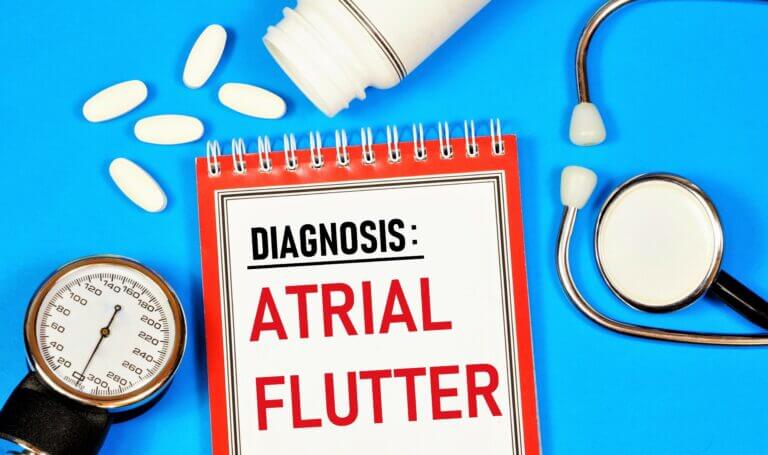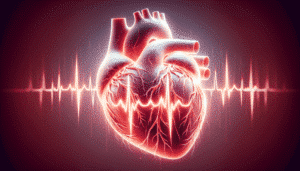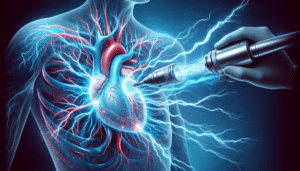What You Should Know About Atrial Flutter
While atrial fibrillation (Also known as AFib) is one of the better-known heart rhythm disorders, it isn’t the only one. Another common heart arrhythmia is called atrial flutter. Both arrhythmias can cause a rapid heart rate and increase risk for stroke. There are so many similarities that I frequently refer to atrial flutter as the cousin of atrial fibrillation.
While atrial flutter shares many similarities with AFib, there are a few key differences to discuss.
What is Atrial Flutter?
Normally your heart beats between 60 and 100 times per minute. The normal beats begin with an electrical signal sent out from a small area in your heart’s right upper chamber (atrium) called the sinus node. The electrical impulse then travels through the heart muscle, triggering it to squeeze.
In the most typical form of atrial flutter, a short circuit forms allowing the electrical signal to travel rapidly around the right atrium at a typical speed between 240 and 340 contractions per minute. These rapid contractions can prevent the chambers from filling completely between heartbeats. There are also less common forms of atrial flutter where the short circuit travels in the left atrium, not the right atrium. However, having atrial flutter in the right atrium is more typical form of atrial flutter.
The lower chambers of the heart, the ventricles, also beat faster than normal. Fortunately, they usually do not beat quite as fast as the atria. Many times only every other beat from the atria makes it through to the ventricles. This still results in the heart beating between 120 and 170 times per minute. This rapid heart rate in the ventricles can then lead to similar symptoms of AFib with palpitations or shortness of breath.
Atrial Flutter vs. Atrial Fibrillation: What’s the Difference?
Atrial flutter and atrial fibrillation are both types of arrhythmias (abnormal heart rhythms). They are both caused when there are problems with the electrical impulses of the upper chambers of the heart that make your heart muscle contract. This causes the heart to beat more rapidly than normal.
Many of the symptoms of atrial flutter are similar to symptoms of AFib. The symptoms of rapid atrial flutter are similar to AFib with RVR.
There is also a risk of unwanted blood clots forming in the heart with both types of arrhythmias. These clots can travel to other parts of the body and get stuck in smaller blood vessels. Similar to AFib, these blood clots then lead to an increased risk for stroke. In addition, many patients with atrial flutter will also require blood thinning medications to reduce risk of stroke, similar to AFib.
Patients with atrial flutter are also at increased risk to develop atrial fibrillation as well. In general, AFib is more common then atrial flutter.
One major difference between the two arrhythmias is that your heartbeat is always irregular in atrial fibrillation, but may be regular or irregular with atrial flutter. For example, when someone has a regular form of atrial flutter, a patient’s heart rate may stay consistently at 150 beats per minute for hours or even days. Meanwhile, when in atrial fibrillation or an irregular atrial flutter, the heart rate will frequently fluctuate on a minute to minute bases.
The Atrial Flutter ECG
Although the symptoms of atrial flutter can be similar to atrial fibrillation, your doctor should be able to identify the different arrhythmias through an ecg performed at your doctor’s office.
In the most typical type of atrial flutter, a short circuit begins in the right atrium and travels in a repititive counter-clockwise motion over and over again in the atrium. This gives a characteristic ‘saw tooth’ pattern on an ECG. The bottom line, as seen in the example below, demonstrates the ‘saw tooth’ pattern.
Meanwhile, since atrial fibrillation represents rapid irregular misfires from multiple areas of the atrium, there is no consistent pattern noted on the ECG, so it basically looks like a squiggly line on the bottom of the tracing.
The Signs and Symptoms of Atrial Flutter
Sometimes people with atrial flutter will have no outward symptoms at all.
For those that do experience symptoms, the symptoms largely depend on how fast the ventricles are beating. The higher the rate, the more likely you are to experience uncomfortable symptoms.
Some of the symptoms of atrial flutter can include:
● Palpitations (a feeling of fluttering in the chest)
● Rapid heart rate
● Chest pain
● Shortness of breath
● Feeling lightheaded
● Fatigue
● Low blood pressure
The Most Common Causes of Atrial Flutter
There are several different causes and risk factors for atrial flutter. Many of these risk factors are similar to the causes of atrial fibrillation.
You are at higher risk of developing atrial flutter if you:
● Have a history of heart surgery
● Have heart valve disease
● Have heart failure
● Have coronary artery disease
● Are an endurance athlete
● Have a family history
Additional risk factors for atrial flutter and other types of heart disease include:
● Older Age
● High blood pressure
● Diabetes
● Obesity
● Alcohol consumption
● Lung disease (Such as COPD)
● Sleep apnea
● Hyperthyroidism (overactive thyroid gland)
Common Treatments For Atrial Flutter
The most common treatments for atrial flutter are similar to those used for atrial fibrillation: control the heart rate, restore a normal heart rhythm, prevent unwanted blood clots, and consider procedures such as a catheter ablation.
Control The Heart Rate
Similar to treating atrial fibrillation, one of the first steps in treating atrial flutter is to control the rate at which the lower chambers (ventricles) contract. This helps the heart pump blood more efficiently.
This is usually done with medications. Common medications used include calcium channel blockers, such as diltiazem or verapamil which slow the electrical impulses, or beta-blockers, such as propranolol or atenolol. When the heart rate is not controlled on either beta-blockers or calcium channel blockers, additional medication such as digoxin or amiodarone may be used cautiously to control the heart rate.
Prevent Blood Clots
The current guidelines recommend taking an anticoagulant or blood thinner if you have been diagnosed with atrial flutter in the same way as if you had atrial fibrillation. The higher an individual’s risk for stroke is, the more likely blood thinners will be recommended to reduce risk for stroke.
This is both because atrial flutter carries a risk of causing unwanted blood clots forming due to the irregular blood flow through the heart when it is not beating normally and because many people with atrial flutter also have AFib as well.
Restore Normal Heart Rhythm
Some patients only experience occasional atrial flutter (paroxysmal) and might return to a normal heart rhythm (sinus) on their own. If the flutter is caused by an underlying medical condition, such as an overactive thyroid or valve disorder, treating that underlying condition may restore a normal heart rhythm, but not always.
When unable to be controlled with medications, some patients will need medical intervention in the form of antiarrhythmic medication, synchronized cardioversion (a controlled electric shock), or a catheter ablation.
Commonly used antiarrhythmic medications include drugs such as amiodarone, flecainide, procainamide, or sotalol. These drugs can be effective in 50-60% of patients. Many times these antiarrhythmic medications can help convert the patient out of atrial flutter, and also help control the heart rate during atrial flutter.
Synchronized cardioversion can be effective for 75-90% of patients. This involves briefly sedating the patient and delivering an electric shock at a very specific point in the heart’s electric activity to reset the normal sinus rhythm. Read my article here to learn more about the details of cardioversions.
Another treatment option for atrial flutter is a catheter ablation, which I will discuss next.
Atrial Flutter Ablation
Some patients who have atrial flutter may consider having a catheter ablation performed. This involves having a catheter inserted through a small incision in a vein near the groin and threaded up to the right atrium of the heart.
This catheter can then uses energy to destroy a small area of heart tissue which interrupts the atrial flutter circuit in the right atrium. This reestablishes a normal heart rhythm and is successful in about 90% of patients. Patients can typically go home the same day of the procedure.
I always emphasize to patients that there is a significant difference between a catheter ablation for atrial fibrillation vs a catheter ablation for atrial flutter. A catheter ablation for the most typical form of atrial flutter is usually a short procedure of less then 1 hour, with a very high success rate of over 90%, and a much lower risk profile compared to an ablation for atrial fibrillation.
Commonly Asked Questions About Atrial Flutter:
How serious is Atrial Flutter?
Atrial flutter can cause a stroke as well as decrease the long term function of the heart, similar to atrial fibrillation. It is very serious and need to be properly treated to prevent long-term complications.
Is Atrial Flutter worse than AFib?
Both conditions have a significantly increased risk for stroke as mentioned in this article. A good feature about atrial flutter it that is usually easier to treat then atrial fibrillation. In addition, a catheter ablation procedure for typical atrial flutter can have a very high success rate.
Can Atrial Flutter Go Away by Itself?
Atrial flutter may come and go, and stop by itself, similar to paroxysmal atrial fibrillation. When atrial flutter is caused by a reversible etiology, such as hyper-thyroidism, correcting the underlying disorder may also correct the atrial flutter.
However, it atrial flutter goes untreated it can increase risk for stroke as well as congestive heart failure. In addition, the longer atrial flutter goes untreated, there will be an increased risk of developing atrial fibrillation as well.
In Review
Atrial flutter is a type of irregular heartbeat that is very similar to atrial fibrillation. They share similar symptoms as well as treatments.
One major difference is that patients with atrial flutter can still sometimes have a regular pulse rate while the pulse is always irregular with AFib.
The most common treatments for atrial flutter involve controlling the heart rate, restoring a normal heart rhythm, and preventing unwanted blood clots.
Commonly used procedures to restore a normal heart rate, such as an electrical cardioversion or catheter ablation, usually have a very high success rate for atrial flutter.
As always, discuss with your doctor treatment options to help you decide what treatment is best for you.
The Best Atrial Fibrillation Book
Your Complete Guide To AFib: The Essential Manual For Every Patient With Atrial Fibrillation
$15.95 (as of May 31, 2025 13:57 GMT -06:00 - More infoProduct prices and availability are accurate as of the date/time indicated and are subject to change. Any price and availability information displayed on [relevant Amazon Site(s), as applicable] at the time of purchase will apply to the purchase of this product.) The A to Z guide on everything you need to know about atrial fibrillation. Written by AFib expert Dr. Percy Morales MD. Over 120 pages of essential information on medications, procedures, and lifestyles modifications for AFib. Easy to read for every patient.
Shop AFib Products on Amazon
KardiaMobile 6-Lead Personal EKG Monitor – Six Views of The Heart – Detects AFib and Irregular Arrhythmias – Instant Results in 30 Seconds – Works with Most Smartphones - FSA/HSA Eligible
13% Off
KardiaMobile 1-Lead Personal EKG Monitor – Record EKGs at Home – Detects AFib and Irregular Arrhythmias – Instant Results in 30 Seconds – Easy to Use – Works with Most Smartphones - FSA/HSA Eligible
$79.00 (as of May 31, 2025 13:57 GMT -06:00 - More infoProduct prices and availability are accurate as of the date/time indicated and are subject to change. Any price and availability information displayed on [relevant Amazon Site(s), as applicable] at the time of purchase will apply to the purchase of this product.)
Apple Watch Series 9 [GPS 41mm] Smartwatch with Storm Blue Aluminum Case with Silver Sport Band M/L. Fitness Tracker, Blood Oxygen & ECG Apps, Always-On Retina Display
(as of May 31, 2025 07:04 GMT -06:00 - More infoProduct prices and availability are accurate as of the date/time indicated and are subject to change. Any price and availability information displayed on [relevant Amazon Site(s), as applicable] at the time of purchase will apply to the purchase of this product.)
Fitbit Sense 2 Advanced Health and Fitness Smartwatch with Tools to Manage Stress and Sleep, ECG App, SpO2, 24/7 Heart Rate and GPS, Shadow Grey/Graphite, One Size (S & L Bands Included)

OMRON 2-in-1 Upper Arm Blood Pressure Monitor & 1-Lead EKG Monitor - Clinically Validated Blood Pressure Arm Cuff & Machine - Use OMRON Connect App
17% Off
Samsung Galaxy Watch 6 44mm Bluetooth Smartwatch, Fitness Tracker, Personalized HR Zones, Advanced Sleep Coaching, Heart Monitor, BIA Sensor, Health Wellness Insights, Big Screen, US Version, Graphite
52% Off $329.99 (as of May 31, 2025 06:01 GMT -06:00 - More infoProduct prices and availability are accurate as of the date/time indicated and are subject to change. Any price and availability information displayed on [relevant Amazon Site(s), as applicable] at the time of purchase will apply to the purchase of this product.)
Natural Rhythm Triple Calm Magnesium 150 mg - 120 Capsules – Magnesium Complex Compound Supplement with Magnesium Glycinate, Malate, and Taurate. Calming Blend for Promoting Rest and Relaxation.
$20.77 ($0.17 / Count) (as of May 31, 2025 15:43 GMT -06:00 - More infoProduct prices and availability are accurate as of the date/time indicated and are subject to change. Any price and availability information displayed on [relevant Amazon Site(s), as applicable] at the time of purchase will apply to the purchase of this product.)
Pure Encapsulations Magnesium (Glycinate) - Supplement to Support Stress Relief, Sleep, Heart Health, Nerves, Muscles, and Metabolism* - with Magnesium Glycinate - 180 Capsules
$44.60 ($0.25 / Count) (as of May 31, 2025 07:04 GMT -06:00 - More infoProduct prices and availability are accurate as of the date/time indicated and are subject to change. Any price and availability information displayed on [relevant Amazon Site(s), as applicable] at the time of purchase will apply to the purchase of this product.)















![Apple Watch Series 9 [GPS 41mm] Smartwatch with Storm Blue Aluminum Case with Silver Sport Band M/L. Fitness Tracker, Blood Oxygen & ECG Apps, Always-On Retina Display #1](https://m.media-amazon.com/images/I/311xwtp4mFL._SL100_.jpg)
![Apple Watch Series 9 [GPS 41mm] Smartwatch with Storm Blue Aluminum Case with Silver Sport Band M/L. Fitness Tracker, Blood Oxygen & ECG Apps, Always-On Retina Display #2](https://m.media-amazon.com/images/I/41j+8AaUGsL._SL100_.jpg)
![Apple Watch Series 9 [GPS 41mm] Smartwatch with Storm Blue Aluminum Case with Silver Sport Band M/L. Fitness Tracker, Blood Oxygen & ECG Apps, Always-On Retina Display #3](https://m.media-amazon.com/images/I/41jIyxZitnL._SL100_.jpg)
![Apple Watch Series 9 [GPS 41mm] Smartwatch with Storm Blue Aluminum Case with Silver Sport Band M/L. Fitness Tracker, Blood Oxygen & ECG Apps, Always-On Retina Display #4](https://m.media-amazon.com/images/I/41IpNJERjCL._SL100_.jpg)
![Apple Watch Series 9 [GPS 41mm] Smartwatch with Storm Blue Aluminum Case with Silver Sport Band M/L. Fitness Tracker, Blood Oxygen & ECG Apps, Always-On Retina Display #5](https://m.media-amazon.com/images/I/31o17yhfYpL._SL100_.jpg)






































